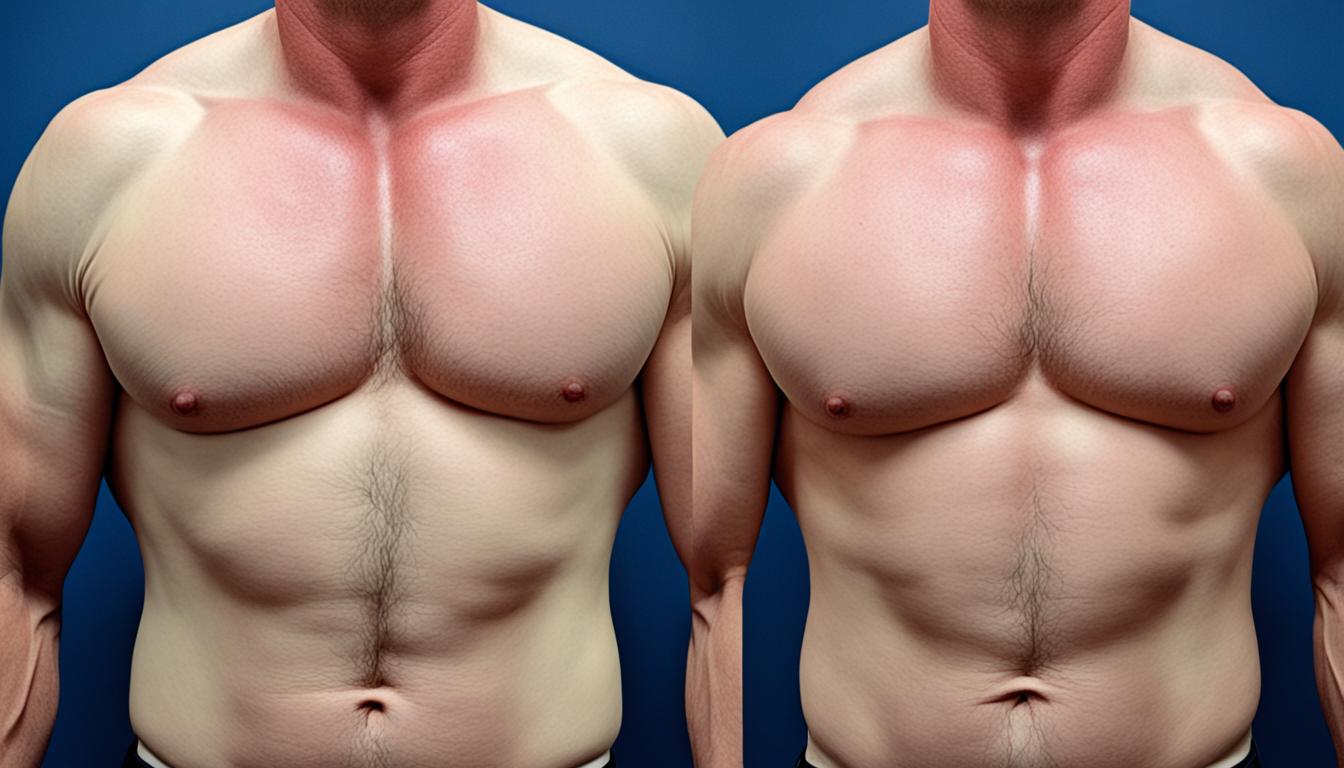Gynecomastia is when men have bigger breasts. It’s not uncommon and can happen at any age. An imbalance in hormones often leads to this. For example, too much estrogen or too little testosterone. Other things that can cause it include drugs, alcohol, and some health conditions.
Knowing the signs of gynecomastia is crucial. Symptoms to watch for are breasts getting bigger, pain, and nipple fluid. Usually, it goes away without needing any treatment. But, if it doesn’t, there are options like surgery or taking hormones.
Now, there’s a new way to treat this with stem cells. It’s showing good results by shrinking the extra breast tissue. This treatment could be a game-changer because it’s safe and may help men feel better about themselves.
Key Takeaways:
- Gynecomastia is a common condition characterized by the abnormal growth and swelling of breast tissue in men.
- The primary cause of gynecomastia is a hormonal imbalance, which can be influenced by various factors.
- Symptoms of gynecomastia include swollen breast tissues, breast pain, tenderness, and nipple discharge.
- While most cases resolve on their own, some may require medical intervention, including surgical treatment or hormone therapy.
- Stem cell therapy is an innovative treatment option showing promising results in reducing excessive breast tissue growth in men.
Risk Factors and Complications of Gynecomastia
Gynecomastia is when men have enlarged breasts. This can happen due to various risk factors and might cause problems in some cases.
Many things can lead to gynecomastia:
- Certain medications: Some drugs like tricyclic antidepressants, HIV medicines, and chemotherapy can cause it. So can anabolic steroids and ulcer medications.
- Drug and alcohol use: Using illegal drugs or drinking too much can mess with your hormones. This makes gynecomastia more likely.
- Hormonal imbalances: Too much estrogen or too little testosterone can make male breast tissue grow.
- Liver and kidney diseases: Diseases of the liver and kidneys can lead to gynecomastia. They affect how hormones work in the body.
- Tumors: Tumors in the testicles, pituitary gland, or adrenal gland can make hormones that cause gynecomastia.
Gynecomastia isn’t always a big problem. But serious cases might cause mental distress. Big breasts can lower self-esteem and make men worry about how they look. Rarely, it’s also linked to a higher risk of breast cancer in men.
Treatment for gynecomastia exists:
- Medication: For mild cases, doctors might give drugs to balance hormone levels and stop breast growth.
- Surgery: Severe gynecomastia can be treated with breast reduction surgery. This operation makes the chest flatter and more manly.
- Hormone therapy: Therapies that reduce the effects of estrogen can also help decrease the size of male breasts.
It’s key to see a healthcare professional for the right diagnosis and treatment. They can figure out the cause of gynecomastia and suggest the best way to fix it.
Diagnosis and Prevention of Gynecomastia
Diagnosing gynecomastia is quite complex and needs a full approach. Doctors look at the symptoms, personal history, and give a deep body check. They do this to see how bad the condition is. They might also do more tests to rule out other health problems.
Blood tests are used to see hormone levels. These tests help find out if there’s a hormonal issue. Imaging tests like mammograms and MRIs check the breast for any issues. A biopsy, taking a sample of breast tissue, might also be done. This is to make sure there’s no cancer.
Preventing gynecomastia entirely is tough. But, there are things you can do to lower the risk. Stay away from drugs and too much alcohol as they mess with your hormones. Always check with a doctor about the side effects of your meds. A healthy weight is also key. Exercise and eat well to keep your body in balance.
Remember, gynecomastia can come from different causes. So, keep in touch with your doctor. If you notice any problems, see a doctor right away. Finding and treating gynecomastia early can make a big difference. It can stop other problems from happening and make treatment more effective.

